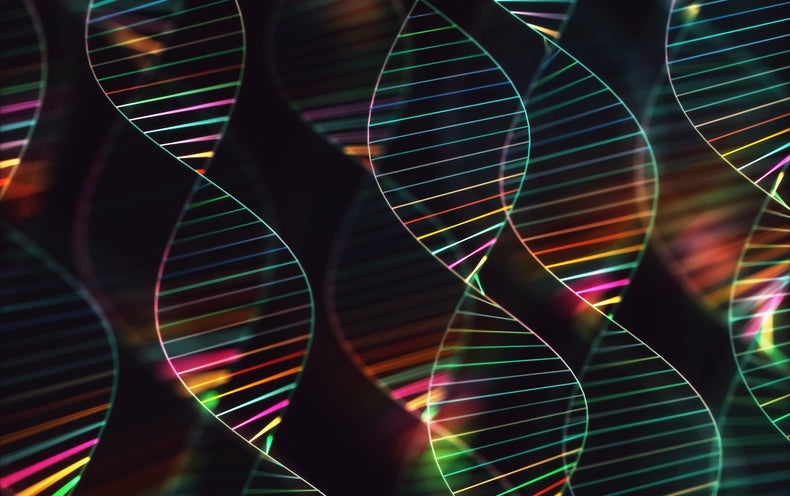
Scientists have pondered a mystery about life for at least a century: Many biological molecules come in two mirror-image versions, just like human hands; in fact, they’re known as “right-handed” and “left-handed.” Natural chemical reactions produce approximately equal numbers of both types of molecule. But the sugars and amino acids that serve as the building blocks of life on Earth have only one handedness which allows proteins and nucleic acids to adopt stable helical structures, like DNA, which, in turn, allows living organisms to evolve and thrive.
The designation of handedness—left versus right—is historical and sometimes appears arbitrary. For example, DNA is right-handed, while the associated amino acids are left-handed. However, what is important is not the naming but the fact that one out of two possible choices has been made. A big question is “Why did one handedness develop and not the other?” Is it a matter of chance or accident or was there a reason for it?
In a recent paper in Astrophysical Journal Letters, we propose a mechanism that might lead to the preferred handedness of life. It starts with cosmic rays: atomic nuclei, stripped of their electrons, which travel through the universe at nearly the speed of light, ultimately smashing into our atmosphere and setting off a cascade of secondary particles. When these particles interact with early living organisms, they caused them to develop the handedness we see today. If confirmed, this would not only solve the mystery, but also give us some clues about how to look for life beyond Earth.
To be clear, we are certainly not the first to connect homochirality with the weak interaction. Vester, Ulbricht, Zel’dovich, Salam and others explored this idea long ago. However, what we believe to be novel and testable in our research is a basic mechanism through which cosmic rays, acting directly on the mutation rate and hence on the evolution of the simplest and earliest living forms, are ultimately responsible for the universal handedness that pervades all life today in all its intricacy and interdependence.
Biological handedness, or homochirality as it is known, has been an intense field of research and debate since its discovery by Louis Pasteur in 1848. It has a counterpart in one of the fundamental forces of physics, called the weak force, which was found in the 1950s to show a similar handedness. Cosmic rays, or more precisely, the showers of secondary particles they produce, and which are created by this weak force, provide a direct link between the asymmetry of physics and the asymmetry of biology.
Cosmic rays are believed to originate in the sun, in exploding stars in our galaxy and around distant black holes. They are commonly viewed as harmful. This is because when a cosmic ray interacts with a biological molecule, it can eject, or ionize, an electron and break the chemical bonds that join atoms together. If the intensity of the radiation is high, human beings are made sick or die. This is one reason why traveling to and living on Mars could be very dangerous. At very high radiation levels, all life would be destroyed.
However, low levels of ionizing radiation can cause mutations of biological molecules and promote genetic variation. This allows small, gradual changes to be made in living organisms that help them to explore better ways to survive in changing environments. This is evolution at work. As is commonly claimed for red wine, small doses are beneficial!
What does this have to do with homochirality? When elementary particles have both electrical charge and a quantum feature called spin, they behave like tiny magnets with a north pole and a south pole. Now, a cosmic ray hitting the atmosphere can create charged spinning particles called muons and electrons, and they preferentially move with the south pole forward. When the muons and electrons encounter a living molecule, these oriented magnets may cause a tiny difference in the rate of mutation of right-handed and left-handed life. Over many generations, perhaps billions or even trillions, this slight bias can cause one handedness to flourish and the other to vanish: homochirality. What is new about this proposal is that it combines a physical cause—cosmic rays—with a chemical property of living molecules—helical structures—to affect the way primitive life evolved.
So, this is the proposed explanation for the handedness of life, and, like all scientific ideas, it should be tested. There are two approaches. The first is to see if life is homochiral everywhere. A key issue facing astrobiology is assessing what environments are hospitable to life. We don’t know how and where life formed, but we are actively seeking it, on the surfaces or subsurfaces of the other planets in the solar system, on their icy moons, in asteroids and even in comets. Some of these extraterrestrial environments contain sugars and amino acids. If they are also found to exhibit life, then it should have the same handedness as life on Earth because it is exposed to the same cosmic rays.
The second approach is to perform experiments. This is a challenge when we do not understand how life formed! However, we can make muons and electrons with south-forward and north-forward magnets and see if there is a difference in how they interact with biological molecules and perhaps even viruses and bacteria. There have been numerous theoretical analyses and experiments aimed at determining the possible role of magnetically polarized electrons (or circularly polarized light) in chiral-selective chemistry—but not in chiral selective biology.
However, what is most exciting of all is to be able to ask these questions at a time when so much is being discovered and to be prepared to be surprised by their answers.
"and" - Google News
July 22, 2020 at 06:30PM
https://ift.tt/32KExTU
Cosmic Rays and the Handedness of Life - Scientific American
"and" - Google News
https://ift.tt/35sHtDV
https://ift.tt/2ycZSIP
And
Bagikan Berita Ini














0 Response to "Cosmic Rays and the Handedness of Life - Scientific American"
Post a Comment